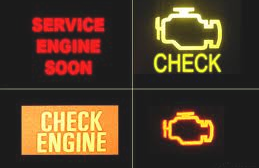Recognize any of these?

All model year vehicles 1996 and newer are equipped with On board Diagnostics version 2 or “OBDII”. This system is used to check if all engine control systems are operating as designed.
How the system works
There are many components in an engine control system. At the heart of the engine control system is the Engine Control Module or “ECM”, also commonly referred to as the “PCM”
or “Engine Computer”. The ECM receives input data from various sensors which are located in different areas of the engine. These sensors report the status of the system they monitor. The ECM takes this data and uses it to make corrections to things like air/fuel mixture or idle speed. The OBDII system will randomly run checks on all of the systems it controls to verify that all data parameters are within their respective thresholds. If any of these parameters are found to be out of their operating range, The ECM commands the Malfunction Indicator Lamp or “MIL” on. This is your Check Engine, or Service Engine Soon warning that you see on your instrument cluster. And that’s it! A complex system of sensors, relays, motors, switches and wiring but the OBDII self check is based on elementary school math and is dead simple. Check the parameters and if one or more of them is higher or lower than the specified limit, turn the light on. From here, the real diagnostic work must be done and that, is on the technician and his/her tools.
How to diagnose a Check Engine Light
There are generally several steps taken to provide a full and accurate diagnosis of your Check Engine Light problem(s):
- Retrieve – When an OBDII system illuminates the MIL, it also stores what are called “trouble codes”. These codes are generally 4 digits long and they point to the area where the problem was spotted. Sort of like how an alarm system in your home is divided into ‘zones’.
- Analyze – The next step is to analyze the trouble code(s). This step has quite possibly the greatest margin for error. The reason behind that is just because your car’s ECM reported a problem with the Bank 1 air/fuel ratio sensor for example, doesn’t mean there is a problem with the sensor. There are a number of other problems that could cause issues on that circuit and may not even have anything to do with the part itself! Replace a $300 sensor just to find your Check Engine Light on 2 days later or replace that $8 vacuum hose that has a leak and actually fix the problem?
- Pinpoint Testing – This step involves an in-depth knowledge of how all the systems on the vehicle operate and work together. After the technician determines the actual location of the problem, he/she then has to isolate everything on that circuit to pinpoint the exact location of failure. Once this location has been focused, diagnostic equipment is used to test the components. Monitoring voltages at those components and comparing to what the specification is and what the ECM is seeing and specifically discerning where/what the exact point of failure is.
Parts stores like Autozone and Pep Boys offer what they call a “free engine scan”. When a driver has a Check Engine light on, he/she can take his/her vehicle to an AutoZone or Pep Boys store for a free diagnosis. A store employee plugs a code reader or basic scan tool into the vehicle’s diagnostic connector and reads out the code. The customer is then sold parts that sound like they might fix the problem. Unfortunately, as we outlined above, it’s not as simple as it sounds. A trouble code is only a starting place, certainly not a conclusive diagnosis.
The ASE certified technicians at Padonia Auto Service have been trained in engine performance and diagnostics. They possess literally thousands of dollars worth of diagnostic equipment, much of which is computerized. If were as easy as reading codes out, cars wouldn’t have Check Engine lights, instead they’d just have a readout of what parts have failed and how to replace them.
If your Check Engine or Service Engine Soon light has come on, its a good idea to get it checked out even if the vehicle still seems to run correctly. The reason is that if the light is on for a benign reason now, you won’t know later on if there is a new, more serious problem because the Malfunction light is already on.



 We employ ASE Certified technicians, the industry standard for automotive repair certifications. Only the most committed technicians will test and become certified.
We employ ASE Certified technicians, the industry standard for automotive repair certifications. Only the most committed technicians will test and become certified.

